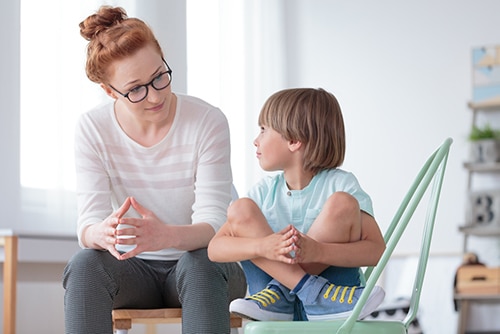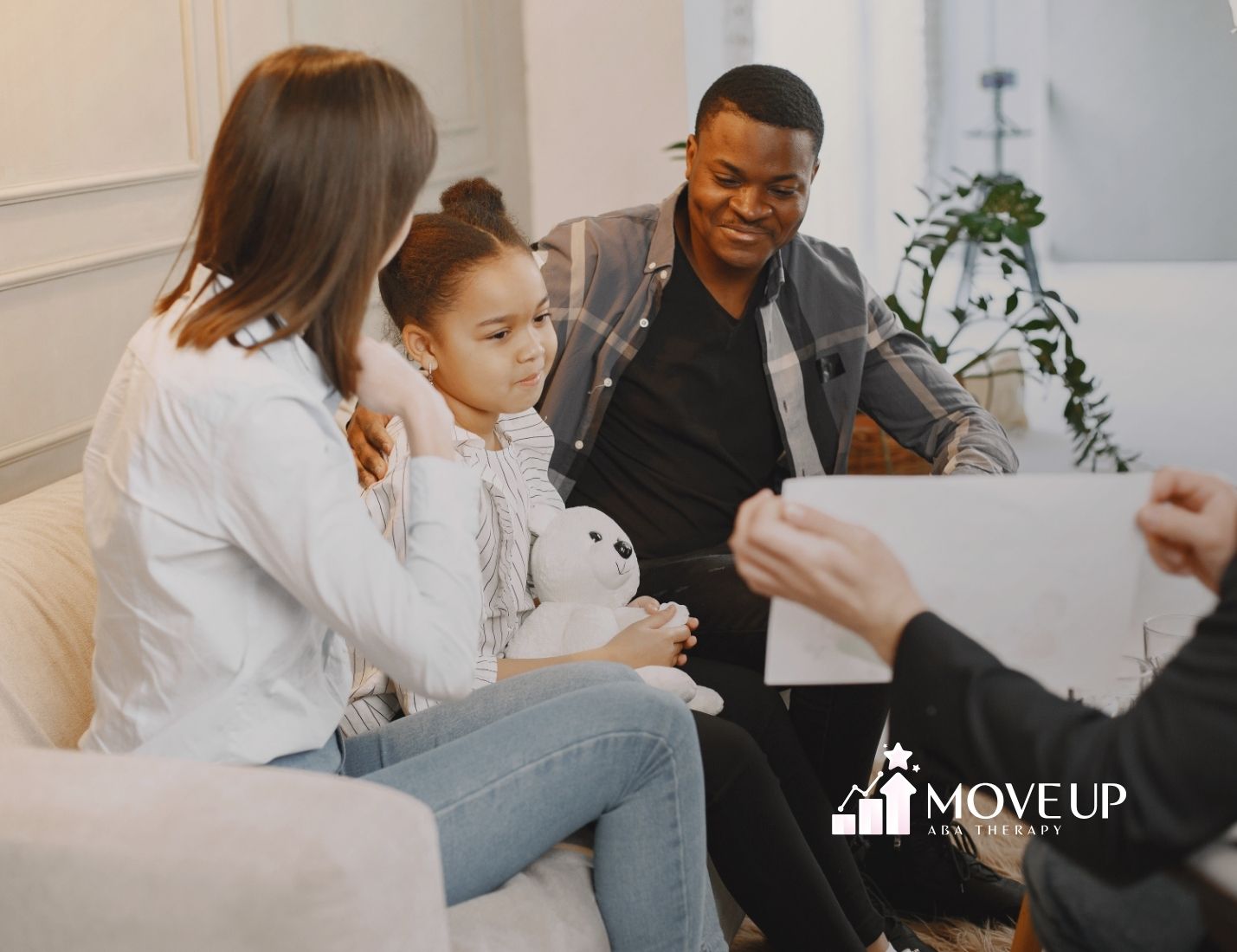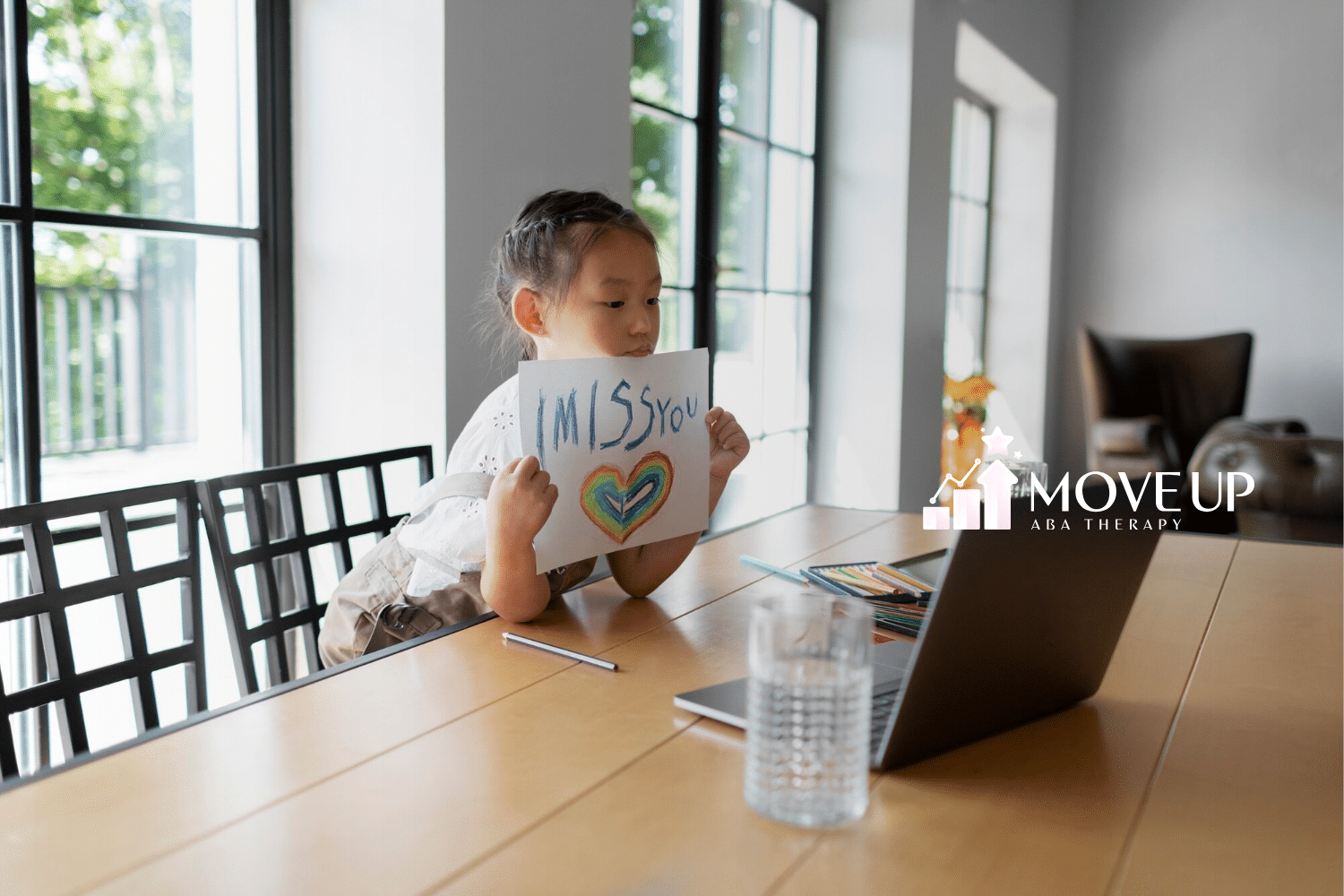How to Prepare Home for In-Home ABA Therapy It’s crucial to understand how to prepare home for in-home ABA therapy and set up a supportive atmosphere for therapy sessions. In-home ABA therapy, also referred to as Applied Behavior Analysis, serves as a treatment choice for children diagnosed with autism spectrum disorder (ASD).
Therapy sessions can occur in the child’s home, offering comfort and familiarity. This setup helps decrease stress and anxiety linked to environments while also allowing therapy to happen in a natural setting.
Using these suggestions, you can establish a setting for your child’s therapy and guarantee the effectiveness of their ABA therapy sessions at home.
How to Prepare Home for In-Home ABA Therapy
When beginning therapy sessions at home for ABA therapy, set up an area dedicated to treatment with distractions. Make sure to gather the therapy tools recommended by your therapist, create a schedule for your sessions, and maintain communication with your therapist to coordinate objectives and keep track of progress.
Success Stories
“Move Up ABA has been a lifeline for our family. Before starting therapy, our son struggled with daily routines and communication. Now, he’s more independent and even initiated a conversation with a classmate for the first time! The progress we’ve seen in just six months is truly remarkable.”
- Emily R., Silver Spring, Accountant
“As a single dad, I was overwhelmed trying to manage my child’s behavior. The Move Up ABA team not only provided amazing support for my little girl but also taught me practical strategies to use at home. Their in-home sessions fit perfectly with our busy schedule. I’m so grateful for their patience and expertise.”
- Michael T., Rockville, Middle School Teacher
“We were hesitant about starting ABA therapy, but Move Up ABA’s approach put us at ease from day one. Our twins have made incredible strides in their social skills and self-regulation. The therapists are like extended family now, and we couldn’t be happier with our decision to work with them.”
- Aisha and James L., Simpson, Police Officers
Ready to start your child's journey to success? Schedule a free consultation today! 📞 Call (410) 497-8865.
1. Designate a Dedicated Therapy Space

By setting aside a spot, for therapy you establish a boundary between therapy sessions and other household tasks. When selecting the therapy area take into account the surroundings. For instance if your child finds solace in nature you could opt for conducting therapy sessions on a porch or, in the garden.
The objective is to establish an environment where your toddlers can participate in therapy exercises comfortably and calmly. Clearing away any mess or objects that could lead to distractions during sessions can also contribute to fostering a concentrated and effective therapy setting.
2. Organize Therapy Materials and Toys
Efficiently arranging therapy tools and playthings is key when setting up your home for, in house ABA therapy sessions. These items are vital, for assisting your child in acquiring abilities and encouraging behavior. By arranging them in an easily reachable way you can guarantee that therapy sessions proceed smoothly and effectively.
It might be helpful to organize and tag therapy tools and toys according to their intended use and the skills they target. This way it will be simpler for you and the therapist to find and utilize items, during therapy sessions. Also remember to have your childs toys in the therapy space. Having toys that your child loves can boost their interest and involvement, in therapy.
Make sure to check and refresh the therapy tools and toys on a basis to keep them exciting and interesting, for your child. Bringing in items from time, to time can help sustain your childs attention and improve their learning journey during therapy sessions.
3. Ensure a Comfortable Seating Arrangement
Ensuring a seating setup is crucial to enhance the effectiveness of, How to Prepare Home for In-Home ABA Therapy. The seating arrangement must be comfy and encouraging enabling your child to concentrate and participate in therapy tasks without any discomfort or interruptions.
When setting up for therapy sessions it’s an idea to use furniture that fits your childs age and size. This can make them feel more at ease and comfortable. Also make sure the seating is arranged in a way that promotes interaction, between your child and the therapist. You could position chairs or seating areas facing each other to encourage eye contact and communication.
4. Minimize Distractions in the Therapy Area
It’s important to reduce interruptions, in the therapy space to ensure a learning setting for, in home ABA therapy sessions. Distractions can interfere with your childs concentration making it difficult for them to participate fully in therapy exercises.
Clear out any things that could distract your child during therapy sessions. This means getting rid of gadgets, TVs, and anything else that might catch their eye or ear. Keep the therapy space neat and tidy to avoid mess and set up a concentrated atmosphere.
Keep the therapy room quiet and peaceful, free from noise like traffic or household sounds. This will allow your child to focus better on therapy tasks and activities, leading to improved concentration and progress during therapy sessions.
5. Create a Visual Schedule
Designing a timetable proves to be a method to establish consistency and order, in ABA therapy sessions conducted at home. Utilizing aids, like schedules, timers, and image cards, can assist your child in grasping and adhering to the therapy agenda, thereby lessening stress and improving their communication and comprehension abilities.
Create a timetable that shows the order of therapy tasks and rest periods. You can use a whiteboard, sheet of paper or a digital visual schedule application. Incorporate pictures and tags to depict each task and break helping your child grasp and prepare for what follows.
Make sure to go over the timetable, with your child at the start of every therapy session to help them grasp and get involved. Let your child have a say, in making and updating the schedule so they feel a part of their therapy routine.
6. Set Up Safety Measures and Accessibility
Ensuring safety measures and making sure the, in home ABA therapy environment is secure is essential. It’s important to be proactive in recognizing and dealing with any dangers or safety issues, in the therapy space.
Make sure to set up safety gates or barriers in your home to limit your childs access, to areas. This includes stairs, balconies and rooms containing hazardous objects. Additionally be sure to fasten furniture and electronic devices to prevent them from tipping over or falling down.
Make sure to check the therapy area for any dangers, like loose wires, sharp items or slippery floors and deal with them right away. Ensure that the therapy room is easy for your child and the therapist to reach taking into account any mobility or sensory requirements.
By putting in place safety precautions and making sure everything is easily reachable you establish an nurturing setting that enables your child to concentrate on therapy tasks and enhances their welfare.
7. Incorporate Sensory-Friendly Lighting and Decor
Using lighting and decorations that are soothing to the senses can improve the therapy setting for kids with autism. Sensory sensitivities common, in individuals, with autism can impact how comfortable they feel and engage in therapy sessions.
Try using lighting or sunlight to establish a serene and relaxing ambiance, in the therapy space. Steer clear of fluorescent lights that could lead to unease or overwhelm the senses. Additionally you might want to utilize dimmer switches or lampshades to regulate the brightness of the light.
When selecting decorations and furniture for your childs space opt, for items that’re cozy and sensory friendly. Consider adding bean bags, cushions or soft rugs to create a soothing environment that offers tactile stimulation and encourages calmness. Stay away from visually busy decor that could potentially cause distractions or stress, for your child.
When you set up a space thats comfortable for your childs senses it can make therapy sessions more enjoyable and productive. This way they can concentrate better on learning and developing their skills.
8. Establish Clear Boundaries and Rules
How to Prepare Home for In-Home ABA Therapy, Creating an respectful environment, for, in home ABA therapy requires setting boundaries and rules. By establishing expectations and guidelines your child can better grasp behaviors and foster positive interactions throughout therapy sessions.
- Set guidelines, for how to behave in therapy sessions like showing respect, for boundaries following instructions and using suitable language.
- Make sure to encourage behavior by praising and rewarding it consistently.
- Establish repercussions, for actions, like implementing time outs or revoking privileges.
- Develop a diagram. List to assist your child in monitoring their advancements and achievements throughout therapy sessions.
- Engage your child in setting guidelines and limits giving them a say and a role, in the healing journey.
Establishing boundaries and guidelines helps set up an respectful atmosphere that encourages learning, teamwork and good conduct, in ABA therapy sessions conducted at home.
9. How to Prepare Home for In-Home ABA Therapy Inventory
Creating a stash of rewards is crucial when setting up an engaging environment for, in home ABA therapy. Rewards play a role, in ABA therapy by encouraging and reinforcing behaviors.
- Consider types of rewards that hold value and inspire your child. This might involve stickers, toys, favorite pastimes or words of encouragement.
- Develop a method to provide reinforcement during therapy sessions like implementing a token based reward system or using a chart to track rewards.
- Make sure to have types of materials, on hand in the therapy space making sure they are easy to reach and suitable, for the persons age.
- Rotate your support staff regularly to keep them engaged and ensure their performance remains top notch.
- Collaborate closely with your ABA therapist to create reinforcement techniques that match your childs requirements and objectives.
When you put together a list of rewards you’re setting up an encouraging atmosphere that motivates your child to get involved and make progress, in therapy sessions.
10. Discuss the Therapy Plan with Family Members
Effective communication and engaging family members play a role in the effectiveness of ABA therapy, at home. It’s essential to talk about the therapy plan with family members to make sure everyone is aligned. Can offer consistent support, for your child.
- Share the therapy goals, strategies, and expectations with family members, ensuring that they understand the purpose and importance of therapy.
- Encourage your family members to join or watch therapy sessions so they can pick up ABA techniques and strategies to help your childs progress beyond the therapy sessions.
- Keep the channels of communication, with your family members. Motivate them to discuss their thoughts, worries or ideas about the treatment approach.
- Make sure to keep your family members informed about how your child’s doing in therapy and share any progress or accomplishments, with them on a basis.
- Create an encouraging atmosphere that allows family members to play a role in the therapeutic process.
When you talk to your family about the therapy plan you’re building a support system that boosts the impact of ABA therapy at home and helps your child grow in every way.
How to Structure an In-Home ABA Session?

Enhancing the, in home ABA therapy experience to be supportive and enriching includes boosting therapy goals and fostering skill development in a setting.
By incorporating activities that your child enjoys into therapy sessions you can boost their motivation and involvement making the sessions more fun and fulfilling.
Engaging siblings and other family members, in therapy sessions encourages family involvement and aids in your childs development. It also creates chances, for socializing and strengthening sibling relationships.
How to Prepare Home for In-Home ABA Therapy By creating a nurturing and encouraging setting keeping communication tailoring strategies to each individual you can establish a healing space that enhances your childs chances of achieving their potential.
1. Integrate Preferred Activities into Sessions
Incorporating activities that your child loves and finds motivating into ABA therapy sessions at home can greatly boost engagement and support skill growth. These preferred activities, whether they involve toys, hobbies or interests can help enhance your childs motivation during therapy sessions making them more enjoyable and beneficial.
Discover what activities your child enjoys the most and integrate them into therapy sessions as rewards or chances, for learning. This could involve playing with toys taking part in experiences or engaging in favored pastimes.
By incorporating activities that your child enjoys you can make the most of their interests. Offer fulfilling experiences that encourage involvement, skill enhancement and advancement, in therapy.
2. Use Technology and Apps Supportively
Integrating technology and apps in a manner during ABA therapy at home can significantly improve the journey. Use apps created for analyzing behavior and improving skills to complement approaches. Engaging games and educational apps customized to your childs requirements can enhance the learning process.
Using technology can help with aids monitoring progress and finding ways to encourage positive behaviors. By incorporating these tools you can establish an interactive and successful therapy setting tailored to your childs needs.
3. Regularly Update the Therapy Space
In order to keep the therapy environment lively it’s important to update the therapy space. This approach encourages involvement. Avoids boredom ultimately improving the quality of therapy sessions. In conversations like does Kanye West have autism, creating an effective therapy setting is often discussed as a key to success. By adding elements reorganizing furniture or changing up toys you can maintain interest and address changing preferences effectively.
A new setting promotes improvement, in skills and positive reinforcement of behaviors. Regularly update the therapy area to maintain an environment that supports learning and development creating an inspiring space, for therapy sessions.
4. Schedule Breaks and Leisure Time
Don’t forget to plan some breaks and free time when conducting ABA therapy sessions at home. These pauses are important, for unwinding and recharging which can be beneficial, for both the child and the therapist. Including moments of relaxation can help keep motivation high avoid exhaustion and promote a therapy session.
It’s important to support the child in doing activities they like and find calming focusing on a rounded therapy approach that takes into account the childs needs. Incorporating breaks can really boost the effectiveness of therapy sessions overall.
5. Keep Communication Open with Therapists

Focusing on communication helps foster a nurturing atmosphere that allows for assessment and adaptation of therapy objectives enhancing the childs opportunities, for progress and advancement..
Conclusion
To sum up it’s essential to understand the importance of getting your home ready, for in home ABA therapy to establish an productive setting for therapy sessions. By incorporating the points mentioned and improving the therapy experience with approaches you can maximize the chances for your child to learn and develop. Consistency orderliness, comfort and communication are all factors in guaranteeing an, in home ABA therapy journey.
By including these components and anticipating obstacles of time you can assist your child in advancing and customizing the treatment to suit their individual requirements efficiently. Seize this chance to establish an fruitful therapy environment within your home.
Looking to establish a nurturing setting for your childs ABA therapy? Turn to Move Up ABA, an ABA therapy provider, in Maryland for assistance! Our tailored, in home ABA therapy blends smoothly with your schedule.
Our therapists will work together with you to create an area that helps your child stay focused and engaged during sessions. Move Up ABA supports children with autism to succeed with ABA therapy in the surroundings of their homes. Contact us now to discover how we can assist your child in achieving their capabilities!
Frequently Asked Questions
What Should I Do Before the First ABA Therapy Session at Home?
Before starting the ABA therapy session at your house it’s crucial to have a grasp of the therapy’s goals and objectives. Have a conversation, with the ABA therapist about the treatment plan. Get your home ready to provide a setting, for the therapy sessions.
When preparing the therapy space remember to designate an area that’s conducive, to therapy free, from distractions and safe and easily accessible. Take into account your childs requirements. Likes to create a space that encourages active participation and development.
How to Prepare Home for In-Home ABA Therapy Engaging?
To enhance the therapy environment think about including activities and resources that match your childs passions and objectives. Infuse creativity into therapy sessions to make them enjoyable and engaging. Employ visual aids, games and interactive learning tools to boost skill enhancement.
Customizing the therapy area to suit your childs requirements and likes helps in establishing a setting that fosters engagement and educational opportunities.
What Are Some Common Challenges During In-Home ABA Sessions?
Challenges that often arise during ABA sessions, at home may involve behaviors, family interactions and triggers in the household environment. It’s crucial to discuss these issues with your ABA therapist to develop strategies and coping mechanisms. Collaboration, between you and your therapist can help tackle these obstacles and make therapy a rewarding experience.
How Can I Support My Child’s Progress in ABA Therapy?
Supporting your childs development, in ABA therapy involves staying positive using rewards being actively engaged in therapy sessions and keeping routines. Encourage your childs progress and achievements involve the family and work closely with the therapy team to maintain treatment. By establishing a nurturing and organized atmosphere you can enhance your childs chances of thriving in ABA therapy.
Can In-Home ABA Therapy Be Customized to My Child’s Needs?
Certainly personalized, in home ABA therapy can cater to your childs requirements. ABA therapists design treatment plans according to your childs needs and objectives. The therapy is customized to target skill gaps, challenging behaviors and social interaction difficulties.
The therapy team collaborates closely with you to create a therapy plan that enhances your childs growth and overall development. In home ABA therapy offers an thorough roadmap, for autism treatment that can be adjusted as your childs requirements change over time.





